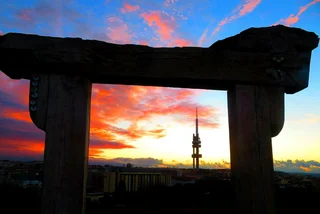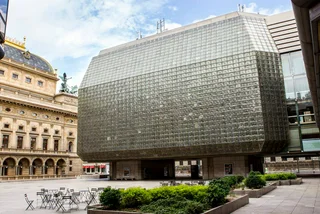Smíchov district hasn’t always been a part of Prague. Just 120 years ago on Feb. 22, 1903, an imperial decree elevated the working-class suburb to city status. A year later it was granted the right to have its own coat of arms, which was identical to the one it had been using without permission for over 50 years.
But the city (město) status was short-lived, as it was among the communities to become part of Greater Prague on Jan. 1, 1922, when the city made its biggest expansion to date. Smíchov and some adjoining areas became Prague XVI. Currently, Smíchov is part of Prague 5.
Smíchov had long eluded efforts at annexation. In 1838 Smíchov was declared a suburb (předměstí) of Prague by Emperor Ferdinand I. As factories and housing began to expand there, the authorities in Prague began to eye the area as a potential source of more taxes.
Efforts to annex Smíchov and Karlín, another designated suburb, were launched in 1849 but both districts flatly refused to negotiate. Only Josefov was interested in joining at that time.
Traces of noble estates
The area of Smíchov had been settled since at least the 13th century, and early references mention it as a home to vineyards. Later, a few noble families had summer estates there, as it was near Prague but offered the opportunity to have large private gardens.
The Porges family had a palace called Portheimka built in the 17th century. It still exists in a modified form and now hosts exhibitions and has a cafe. The summer house for the Kinský family is now the Ethnographic Museum of the National Museum.
The Dušek estate at Bertramka, where Mozart may have stayed while finishing "Don Giovanni," is also a museum. Remnants of a noble park, with fake castle ruins and a fake pagoda, can still be found in Cibulka.
Dense network of factories and working-class housing
It wasn’t until the 19th century that Smíchov began to become important as an industrial center. The Ringhoffer Works was the largest iron foundry in the Austro-Hungarian Empire. Other large industries included the Staropramen brewery, textile works, a sugar factory, and machine works. The neighborhood due to the number of chimneys became known as the Manchester of Bohemia.

Throughout the 20th century, many of the factories closed or moved their production. Of all of these industries, the only one to continue its operations today is Staropramen, which is also the last large brewery left in all of Prague. It was founded in 1871, but the Staropramen name wasn’t trademarked until 1911. The brewery is now owned by Molson Coors Beverage Company.
Apartment buildings also began to fill the area to house not only the workers but also executives and intellectuals. Albert Einstein lived there from 1911 to 1912 when he taught physics at what is now part of Charles University.

Several Art Nouveau-style buildings still remain from this era, such as a market building that is now a branch of the Municipal Library and the nearby National House (Národní dům na Smíchově).
A railway bridge was built in 1871 to connect the people factories in Smíchov to the right bank of the Vltava. The bridge was rebuilt in 1901 with two tracks and three parabolic steel spans to meet the increased traffic demand. It is currently the subject of a dispute, as preservationists want to restore it while the Railway Administration (SŽ) wants to replace it.
No longer an industrial center
Smíchov was one of the first areas in the center of Prague to see gentrification after the Velvet Revolution. New modern offices and shopping malls in the Anděl area opened up starting two decades ago. The facade of the Ringhoffer Works has been incorporated into one of the shops.

Several trendy pubs and eateries also populate the area between Anděl and the Na Knížecí bus depot. The waterfront called Smíchovská náplavka also has been renovated, but more recently, and hosts food festivals and similar events.
Much of the former industrial area is now being rebuilt into new neighborhoods. Construction of Smíchov City on former railway land began in 2020 and will last for at least 12 years. A former distillery is being converted into the Lihovar residential complex, with a few of the original architectural details preserved.

Uncertain origins of the name
The origin of the name Smíchov is hotly disputed. The most common explanation is that it comes from the Czech word for laughter (smích) because according to a legend, a minor nobleman named Horymír escaped execution by jumping over the Vltava river on his horse Šemík, and then laughed once he landed on the Smíchov side.
A more likely explanation is that is comes from the word for mixed (smíchaný), as during the time of Emperor Charles IV in the 14th century, the land was divided into small plots and people from various places lived mixed together. The first actual mention of the name is shortly after 1400.












 Reading time: 4 minutes
Reading time: 4 minutes 






 English
English
 Polish
Polish
 German
German
 French
French




















